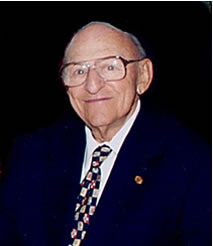

|

|
IN MEMORIAM
Samuel Eiduson
Professor of Biological Chemistry, Psychiatry and Biobehavioral Sciences, Emeritus
UC Los Angeles
1918 – 2007
Sam Eiduson was born and raised in Buffalo, New York. Sam came to Los Angeles in 1938 to attend UCLA as an undergraduate. He obtained his bachelor’s degree in chemistry in 1947 after a break in his education to join the Signal Corps as a First Lieutenant, Cryptographic Maintenance Officer, U.S. Army, United States and South Pacific Theatres. Sam then went on to obtain his Ph.D. in biochemistry from UCLA in 1952. Sam founded, in 1955, the Neurobiochemistry Laboratory at the Brentwood V.A. Hospital, one of the early laboratories in the United States to devote itself to the study of the biochemistry of the brain. He returned to UCLA full-time in 1961, and was continually active in the neuroscience community, both in research and in interdisciplinary education in the neurosciences. Prior to the official initiation of the Neuroscience Interdepartmental Ph.D. Program in 1968, he served on the executive committee of UCLA’s pioneering Mental Health Training Program. Sam served as the first Associate Director for Education in the Brain Research Institute (BRI), and also became the first Chairman of the Interdepartmental Neuroscience Ph.D. Program, in the BRI.
Sam’s early research involved the metabolism of neuroleptics, adrenocortical hormones and the discovery that 5HT decarboxylase differed from DOPA decarboxylase, eventually becoming the AAD (aromatic amino acid decarboxylase) accepted today. He then went on to the study of monoamine oxidase (MAO), gradually dissecting it into its various forms of Type A and B by direct chromatographic analysis and later by techniques such as electron spin resonance. In the course of these studies he examined platelet MAO, examined the MAO’s of schizophrenics, showed phosphatidylserine inhibition of platelet MAO-B and, among other things, examined the relationship between phosphatidylserine content and MOA-B activity in chronic paranoid schizophrenics.
During his career Sam published numerous scientific papers, authored several textbooks, and contributed chapters to many more. Sam was a consultant to the National Institute of Mental Health, as well as a recipient of numerous professional honors. He was a member of several professional societies, including the American Society of Biological Chemists, the American Society for Neurochemistry, International Society for Neurochemistry, the Society for Neuroscience, International Society for Developmental Psychobiology, the American College of Neuropsychopharmacology, and the American Association for the Advancement of Science. Sam “officially” retired in 1989.
Recently the BRI celebrated the 15th Annual Samuel Eiduson Lecture, established in Sam’s honor to recognize an outstanding neuroscience graduate student. Sam attended every Eiduson Student Lecture. Those of us who knew Sam count ourselves fortunate in having known and worked with someone who not only made irreplaceable contributions to his field and the UCLA neuroscience community, but who was a person of great dedication, integrity, and kindness. We will miss him very much.
Chris Evans